
Credit: ©Science China Press
Single-molecule break junction techniques offer unique insights into the charge transport at the molecular level. The conductance through single-molecule junction consists of the through-space tunneling and the through-molecule tunneling conductance. However, the existence of through-space tunneling, which is ubiquitous at the single-molecule level, makes the quantitative extraction of the intrinsic molecular signals challenging.
Although its powerful capability to contact individual molecules, single-molecule break junction techniques are intrinsically not capable of intervening the actual signatures of the junction, such as binding geometries, number of molecules in the junction, interaction between the junction and neighbor molecules, etc.
The widely accepted method to extract the conductance information of a single molecule is to obtain statistics in thousands of break junction processes. Typically, a conductance histogram is plotted to find the most probable conductance. However, to which extent should we trust the obtained conductance? Since the result may affected by many stochastic events, such as junction formation probability, early rupture of the molecular junction, etc., in the break junction process.
What’s more, as the focus of the state-of-art single-molecule break junction measurements has gradually shifted from strong interaction to weak interaction systems (such as supramolecular junctions) and from static processes to more dynamic processes (such as diffusion and chemical reaction processes), can break junction techniques still offer quantitative information at single-molecule level in these systems?
Very recently, Professor Wenjing Hong’s group in Xiamen University, working together with Prof. Jielou Liao’s group in University of Science and Technology of China, explored in detail the quantitative characterization capability of break junction techniques in single-molecule systems through an analytical model (Figure 1). This model describes the conductance changes during the opening process of two gold electrodes and validates the capability of conductance and displacement analyses during the break junction experiments of OAE-type molecule junctions. Based on this model, they demonstrated that the break junction technique can be used to detect the conductance of the molecular system with weak interactions under low junction formation probabilities and early rupture of the formed junction before it reaches a fully-stretched configuration. Using the established simulation approach, they further proved that the break junction technique can offer a quantitative understanding of molecular assembly, diffusion and even reaction processes with complementary conductance and displacement analyses.
###
This work was supported by the National Key R&D Project of China (2017YFA0204902), the National Natural Science Foundation of China (21722305, 21673195, 21703188, 21790360), the Youth Innovation Promotion Association CAS (No. 2015024).
See the article: Pan Zhi-chao, Li Jin, Chen Lijue, Tang Yongxiang, Shi Jia, Liu Junyang, Liao Jie-lou, Hong Wenjing. Analytical modeling of the junction evolution in single-molecule break junctions: towards quantitative characterization of the time-dependent process. Sci. China Chem., 2019, DOI:10.1007/s11426-019-9493-6.
https:/
Media Contact
Hong Wenjing
[email protected]
Related Journal Article
http://dx.




